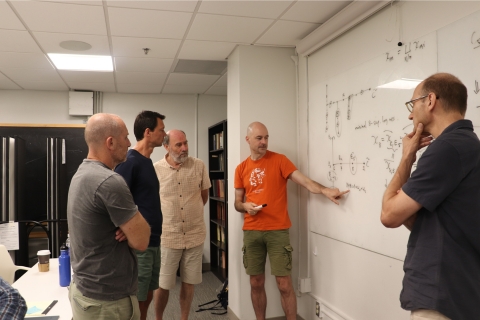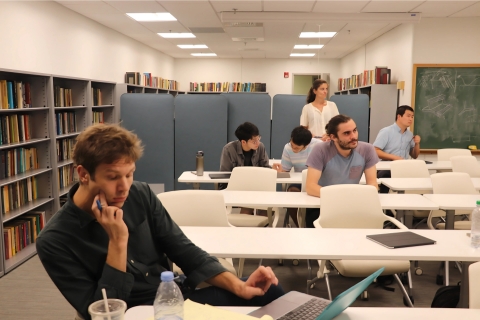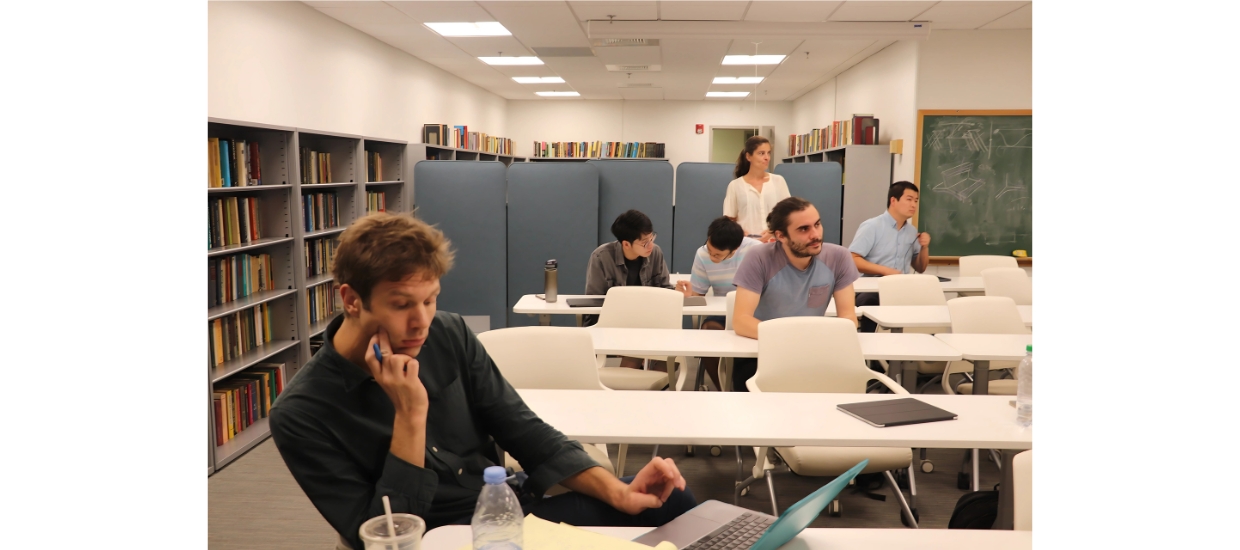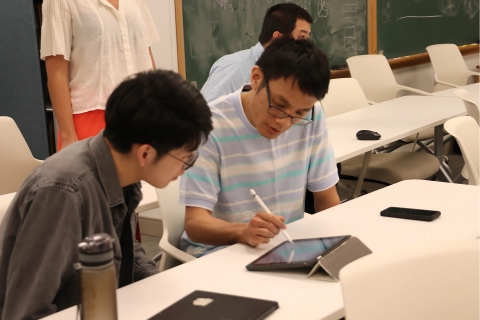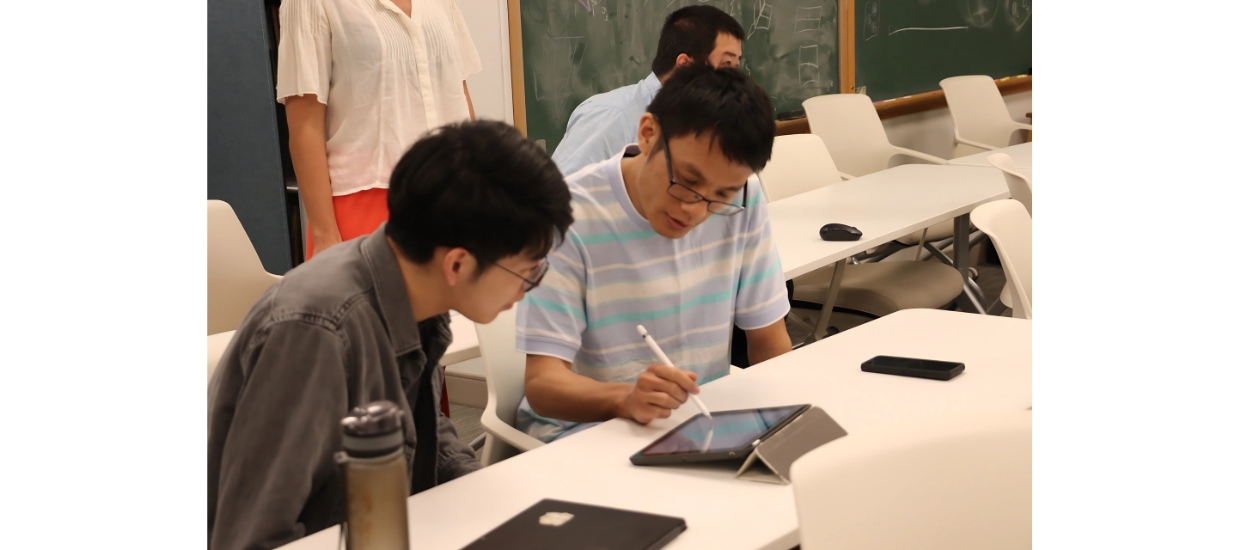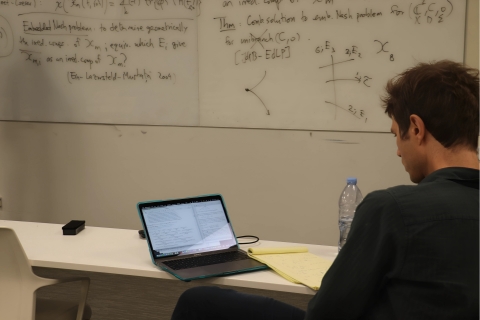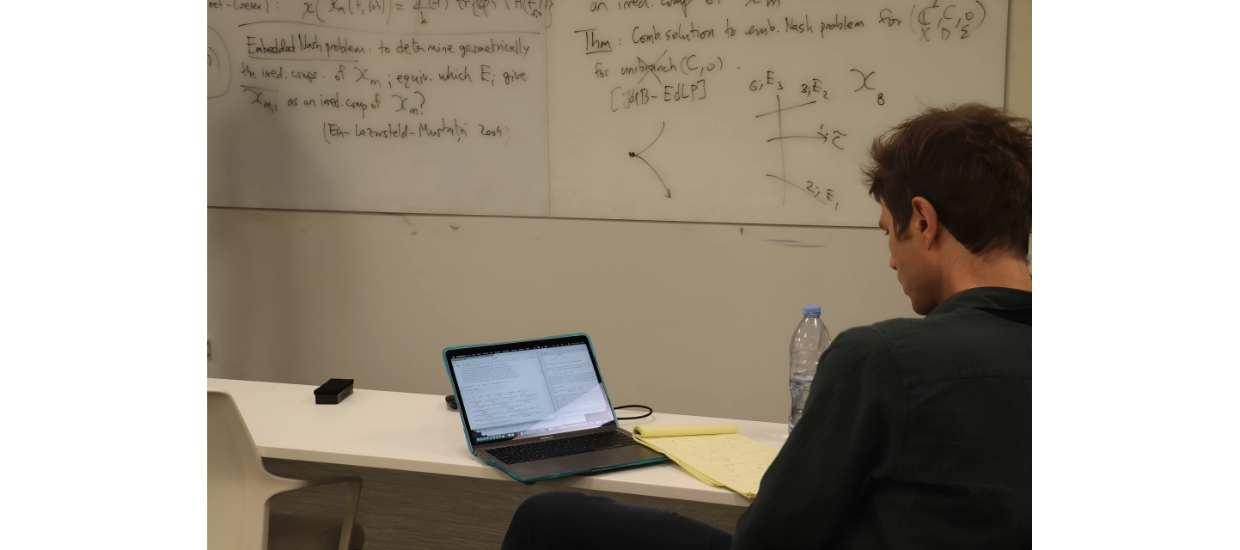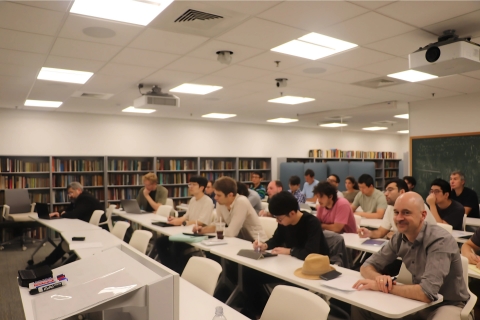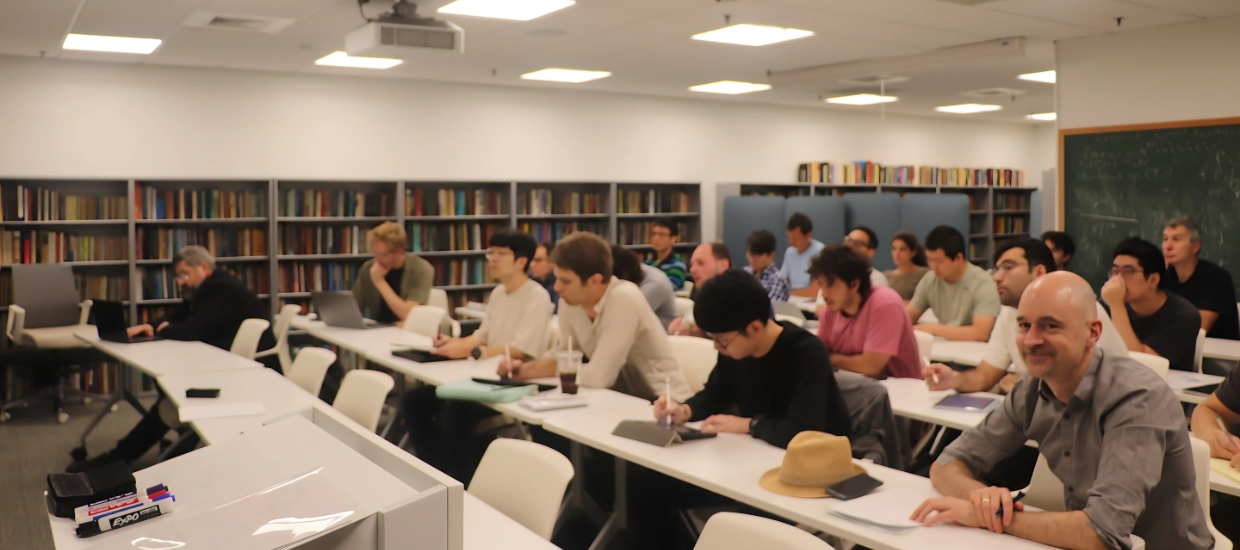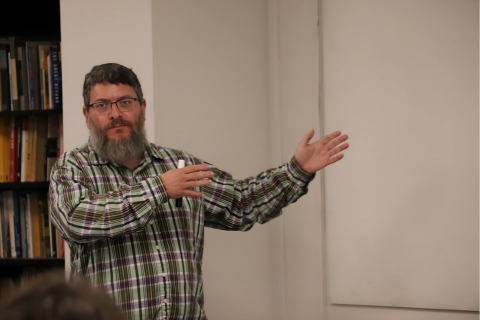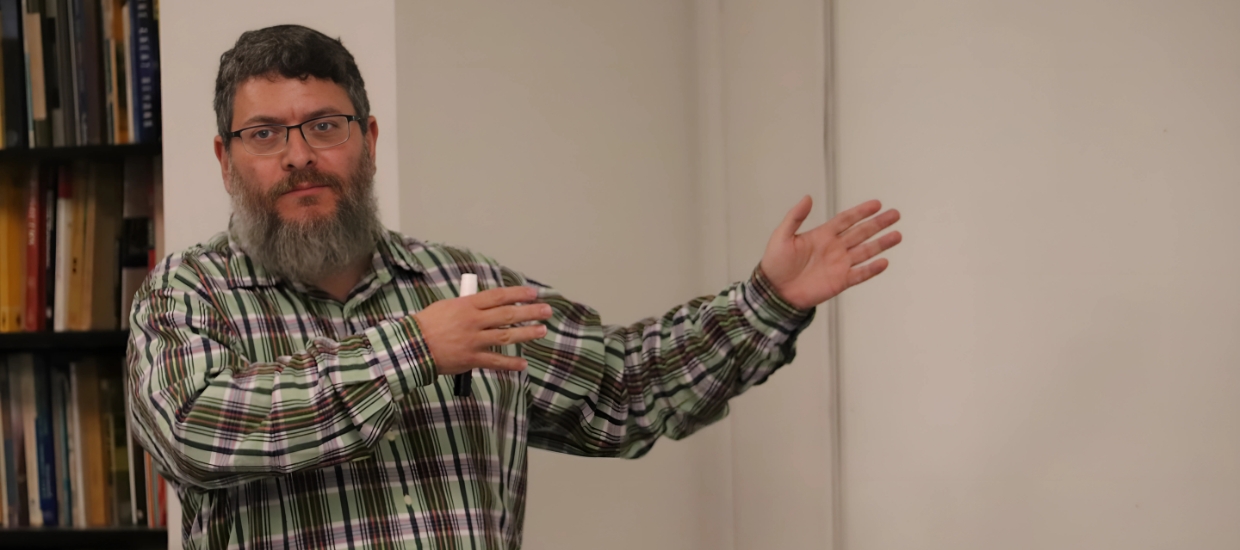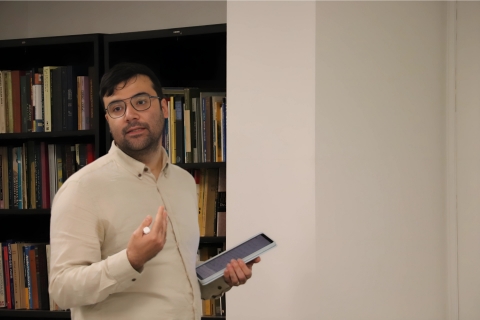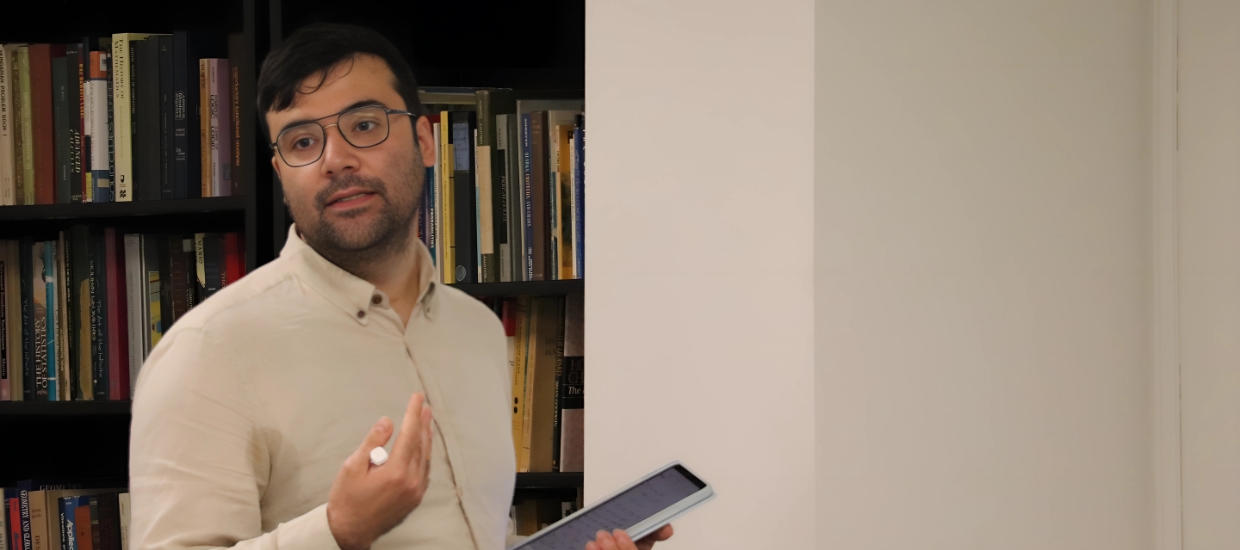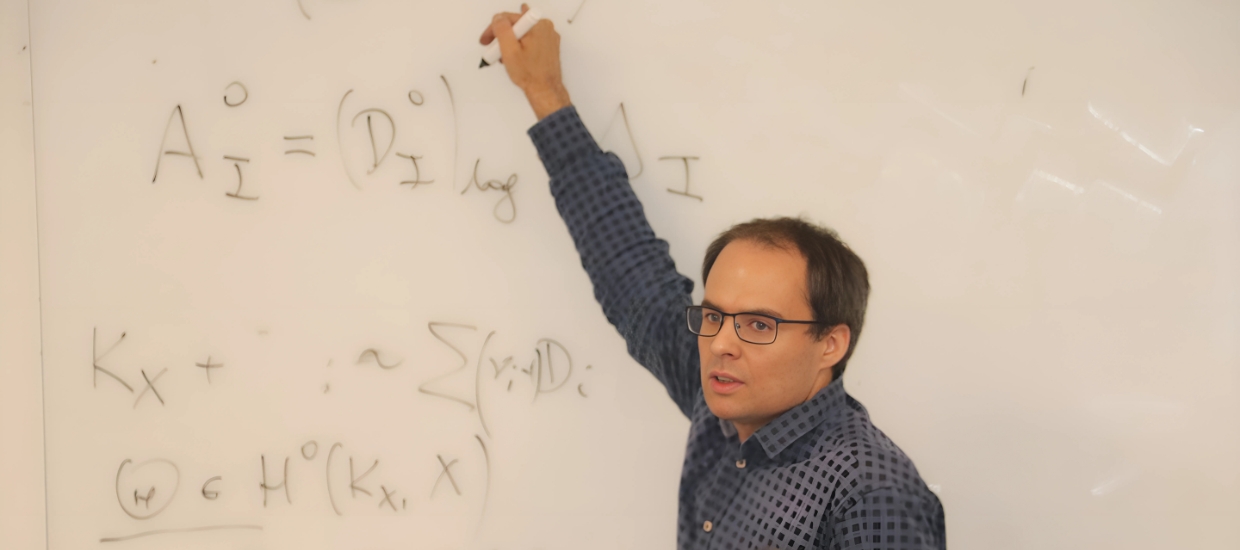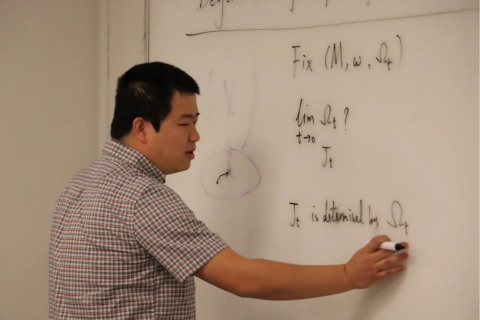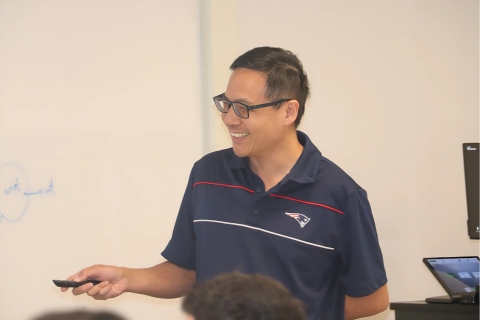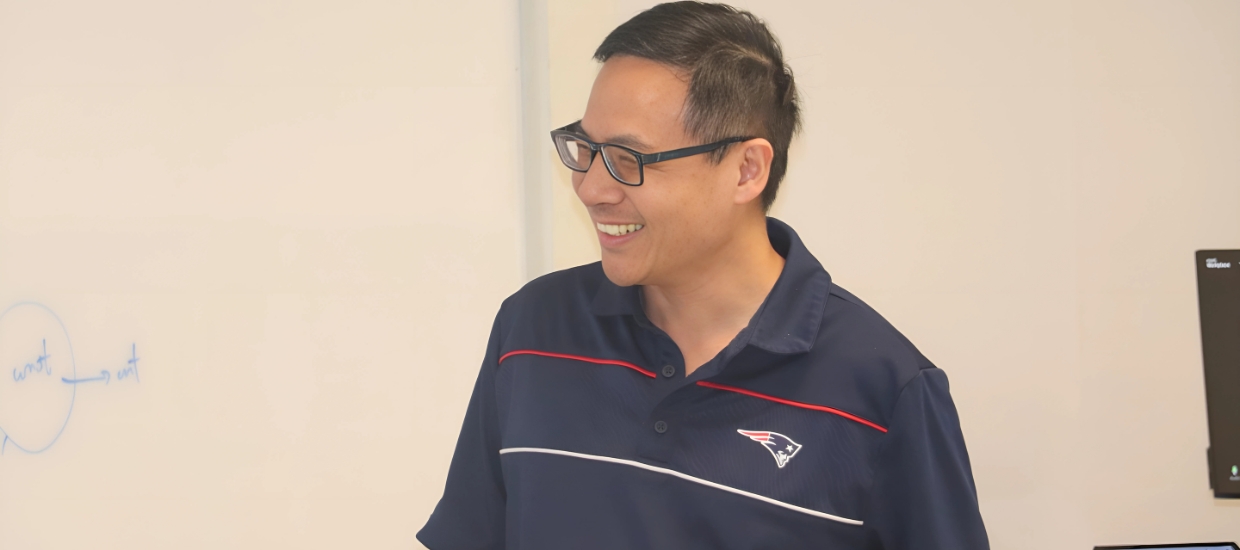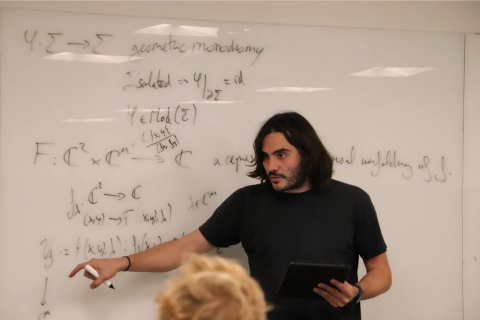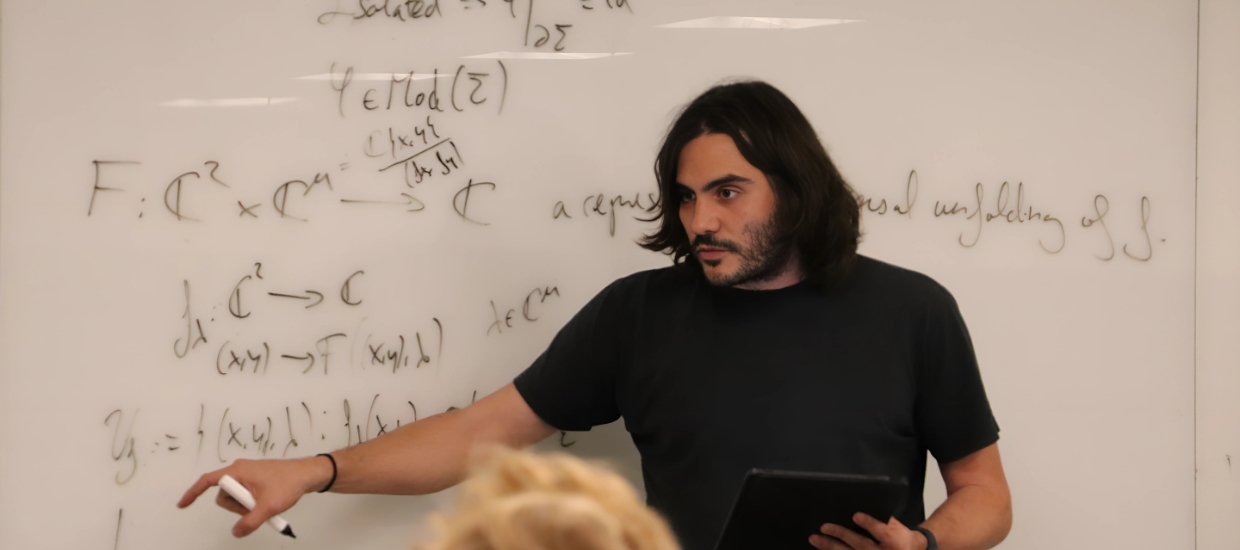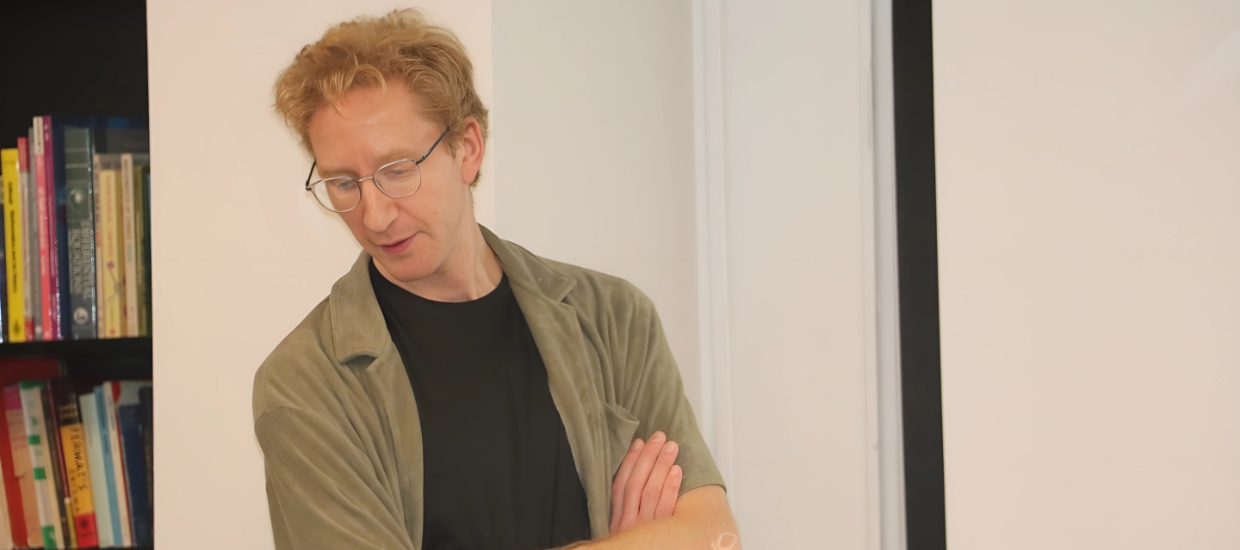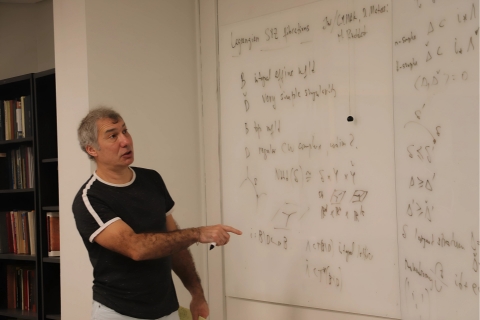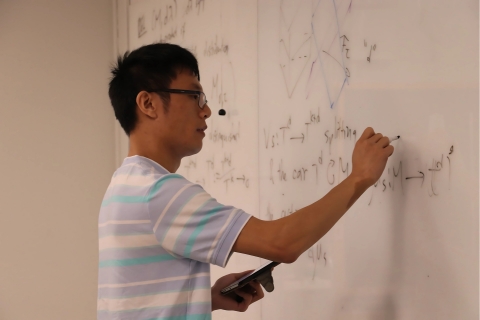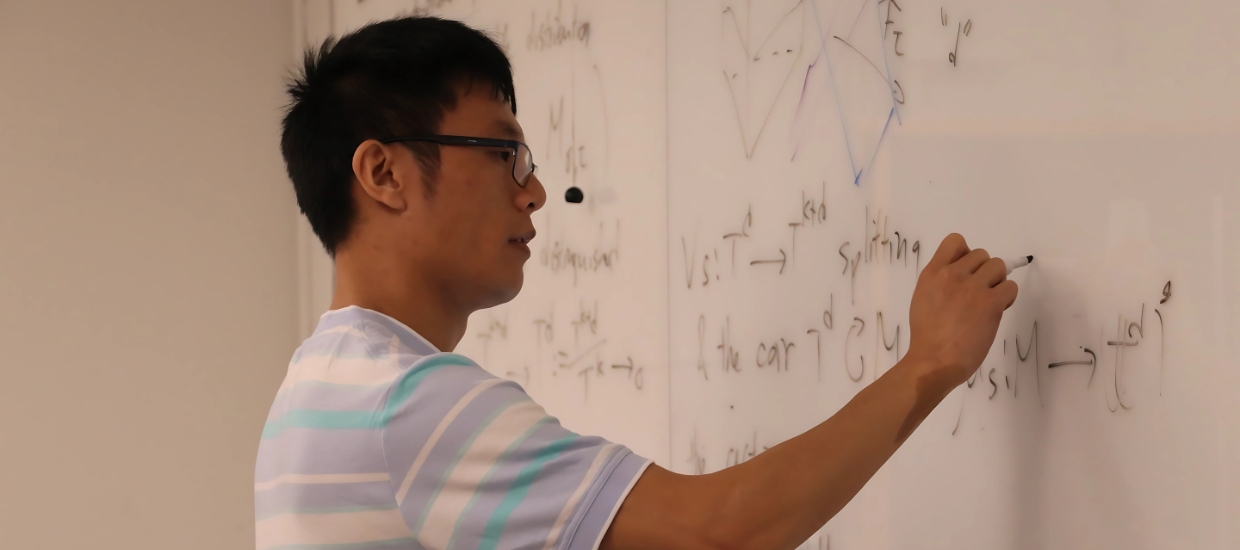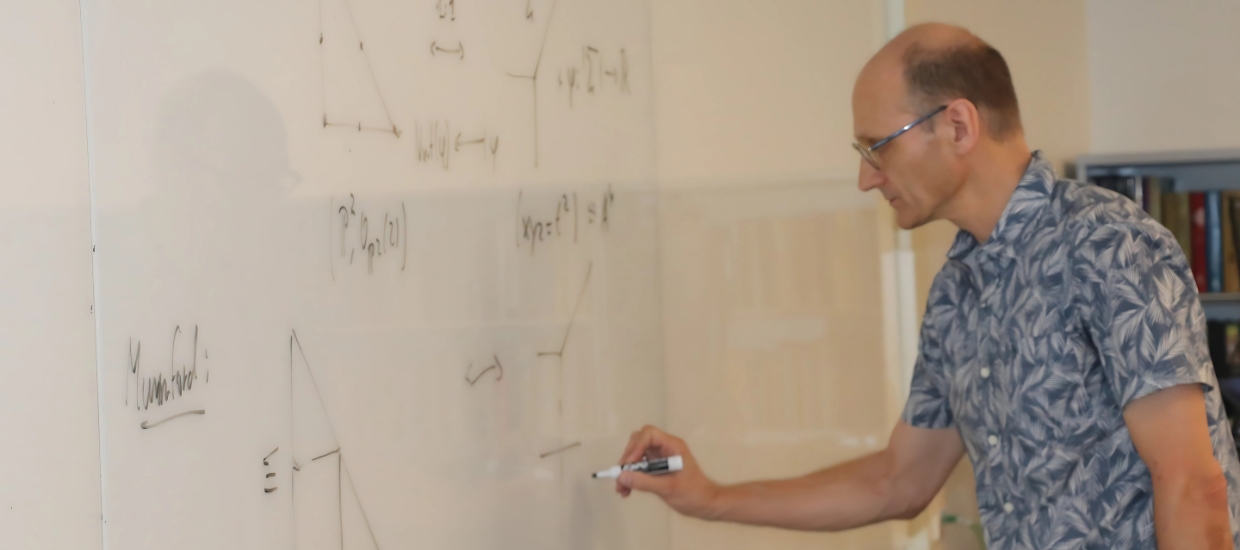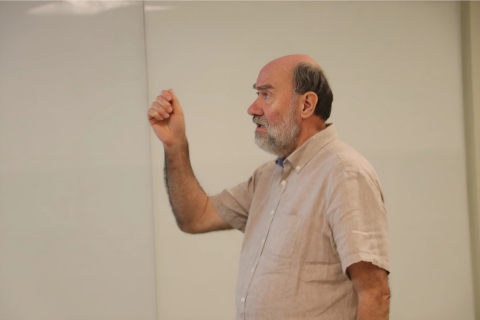Dates: November 18-22, 2024
Location: Ungar Building, Room 528B, University of Miami
Live Video Available via Zoom
Organized by: Helge Ruddat
To register, please click here.
Schedule
Monday, November 18, 2024
| 9:00am |
Bernd Siebert, University of Texas at Austin: From toric degenerations to intrinsic mirror symmetry I
I will survey my joint program with Mark Gross providing an algebraic-geometric perspective on the SYZ dual torus fibrations in mirror symmetry: Our original synthetic approach constructed mirror dual degenerating families with central fibers unions of toric varieties via wall structures. More recently, we were able to define wall structures to construct the mirror toric degenerations via Gromov-Witten theory in general Calabi-Yau geometries ("intrinsic mirror symmetry"). Taken together this provides an algebraic-geometric implementation of the quantum corrections to the complex structure of the mirror SYZ fibration compatibly with both the original differential-geometric and the non-archimedean frameworks. Video
|
| 10:15am |
Jakob Hultgren, Umeå University: SYZ for hypersurfaces of toric Fano manifolds and optimal transport I
The original SYZ-conjecture in mirror symmetry asks for special Lagrangian torus fibrations in Calabi-Yau manifolds. I will focus on families of Calabi-Yau hypersurfaces in toric Fano manifolds. Recent work by Yang Li reduces a weak version of the SYZ-conjecture in this setting to the solvability of a real Monge-Ampère equation on the boundary of a polytope. I will give a brief introduction to this and then explain how, curiously, this Monge-Ampère equation is solvable for some families and not solvable for other families. I will explain how solvability can be described in terms of optimal transport theory, and how another subtle aspect of the PDE: the location of the discriminant locus, becomes less mysterious when viewed through the lens of optimal transport. Finally, I will highlight some of the many open problems related to this. This is based on joint work with Rolf Andreasson, Mattias Jonsson, Enrica Mazzon and Nick McCleerey. Video
|
| 1:00pm |
Cheol Hyun Cho, Seoul National University: On the unit normal correspondence for a monotone divisor complement
We study the relation between the Fukaya category of a monotone divisor and its complement. More precisely, there is a new Fukaya category of the complement (defined using the popsicle maps with the insertions of the Reeb orbits Γ around the divisor) , which is then deformed using a parameter σ. There is a Lagrangian correspondence from the new Fukaya category complement to the monotone Fukaya category of the divisor, which is shown to be an isomorphism in some examples. This is a joint work in progress with H. Bae, D. Choa and W. Jeong. Video
|
| 2:15pm |
Javier Fernández de Bobadilla, Basque Foundation for Science & Tomasz Pelka, Institute of Mathematics of the Polish Academy of Sciences: Lagrangian tori at radius zero
We will present a new technique to construct Lagrangian tori in degenerations of Kahler manifolds. For maximally degenerate families of Calabi-Yaus, these tori have some asymptotic properties expected from the SYZ picture: they fill almost all volume, collapse in the Gromov-Haudsdorff metric to the essential skeleton minus codimension 2 faces, etc. They naturally occur at the boundary of the A'Campo space, which extends a given degeneration from a punctured disk to the annulus. We will explain the construction of the A'Campo space and its hybrid coordinates. Using these coordinates, the proof of the above properties reduces to elementary computations at the boundary. The key part is the definition of a fiberwise Kahler form, which is asymptotically Ricci flat in the generic region, and allows us to move the tori from the boundary to the nearby fibers along its symplectic connection.
Tomaz Pelka Video
J. F. Bobadilla Video
|
Tuesday, November 19, 2024
| 9:00am |
Bernd Siebert, University of Texas at Austin: From toric degenerations to intrinsic mirror symmetry II
I will survey my joint program with Mark Gross providing an algebraic-geometric perspective on the SYZ dual torus fibrations in mirror symmetry: Our original synthetic approach constructed mirror dual degenerating families with central fibers unions of toric varieties via wall structures. More recently, we were able to define wall structures to construct the mirror toric degenerations via Gromov-Witten theory in general Calabi-Yau geometries ("intrinsic mirror symmetry"). Taken together this provides an algebraic-geometric implementation of the quantum corrections to the complex structure of the mirror SYZ fibration compatibly with both the original differential-geometric and the non-archimedean frameworks. Video
|
| 10:15am |
Jakob Hultgren, Umeå University: SYZ for hypersurfaces of toric Fano manifolds and optimal transport II
The original SYZ-conjecture in mirror symmetry asks for special Lagrangian torus fibrations in Calabi-Yau manifolds. I will focus on families of Calabi-Yau hypersurfaces in toric Fano manifolds. Recent work by Yang Li reduces a weak version of the SYZ-conjecture in this setting to the solvability of a real Monge-Ampère equation on the boundary of a polytope. I will give a brief introduction to this and then explain how, curiously, this Monge-Ampère equation is solvable for some families and not solvable for other families. I will explain how solvability can be described in terms of optimal transport theory, and how another subtle aspect of the PDE: the location of the discriminant locus, becomes less mysterious when viewed through the lens of optimal transport. Finally, I will highlight some of the many open problems related to this. This is based on joint work with Rolf Andreasson, Mattias Jonsson, Enrica Mazzon and Nick McCleerey. Video
|
| 1:00pm |
Michel van Garrel, ETH Zürich: BPS invariants of scattering diagrams and spectral networks
On one hand, scattering diagrams were developed by Kontsevich-Soibelman and Gross-Siebert in order to smooth Calabi-Yau geometries. On the other hand, one may associate a spectral network to the mirror curve to a toric Calabi-Yau threefold. To the former, one may associate log BPS numbers counting maximally tangent curves. To the latter, one may associate BPS numbers conjecturally counting stable Lagrangians. For a large class of examples for which the toric Calabi-Yau threefolds have no compact divisors, by passing through intermediate quivers, I will show a correspondence between the respective BPS numbers. I will also explain the heuristics behind the correspondence. Video
|
| 2:15pm |
Siu Cheong Lau, Boston University: Teleman's conjecture and equivariant Lagrangian correspondence
Motivated by gauging topological field theories, Teleman considered a Hamiltonian group action on a symplectic manifold and conjectured that its mirror is a holomorphic fibration. In this talk, I will explain how such a fibration comes up from mirror construction via equivariant Lagrangian Floer theory, and quantum corrections coming from the equivariant obstruction of Lagrangian correspondence for symplectic quotient. Obstruction of Lagrangian correspondence is also related to Seidel elements and degenerations. This is a joint work with Nai-Chung Conan Leung and Yan-Lung Leon Li. Video
Ju Tan, Boston University: Mirror Construction for Nakajima Quiver Varieties
Quiver possesses a rich representation theory, which exhibits a deep connection with instantons and coherent sheaves as illuminated by the ADHM construction and the works of many others. Besides, quivers also capture the formal deformation space of a Lagrangian submanifold. In this talk, we will discuss these relations from the perspective of SYZ mirror symmetry. In particular, we will introduce the notion of framed Lagrangian immersions, the Maurer-Cartan deformation spaces of which are Nakajima quiver varieties/ stacks. If time permits, we will discuss our ongoing projects on the Hecke correspondence and Nakajima's raising operators. This is based on the joint work with Jiawei Hu and Siu-Cheong Lau, and an ongoing project with Siu-Cheong Lau. Video
|
Wednesday, November 20, 2024
| 9:00am |
Ilia Zarkov, Kansas State University: Lagrangian SYZ fibrations
Given an integral affine manifold B with (semi-)simple singularities D in codimension 2, I will explain a strategy how to build a symplectic manifold X and its Lagrangian torus fibration X \to B which extends the tautological cotangent torus bundle over B\D. I will concentrate on building a local model for x..z=1+w_1+..w_n, paying particular attention to the topology of the singular fiber. Technical details as well as gluing local models will be a subject of Cheuk Yu Mak's talk. This is a joint project with C.-Y. Mak, D. Matessi and H. Ruddat. Video
|
| 10:15am |
Cheuk Yu Mak, University of Southampton: Lagrangian torus fibrations over integral affine manifolds with Gross-Siebert type singularities
In this talk, I will report on the joint work in progress with Diego Matessi, Helge Ruddat, and Ilia Zharkov on constructing Lagrangian torus fibrations on symplectic manifolds with prescribed integral affine bases with singularities. This is a continuation of Ilia Zharkov's talk.
We will begin with the construction of local models and their Lagrangian torus fibrations. The construction has two important features:
(i) On a region where there is a bigger torus symmetry, the Lagrangian torus fibration is canonically a `pseudo-product' (not a product!) of smaller local models.
(ii) The local models are hypersurfaces inside toric varieties governed by potential functions.
The former allows us to go between local models of different types without making an additional choice of a splitting of tori. The latter allows us to interpolate different auxiliary choices of local models of the same type. Then we explain how to glue these local models by taking the canonical slice of a canonical family of local models. Video
|
| 1:00pm |
Maria Pe Pereira, Universidad Complutense de Madrid: Moderately discontinuous algebraic topology
In the works [1] and [2] we develop a new metric algebraic topology, called the Moderately Discontinuous Homology and Homotopy. It gives invariants for germs that are topologically cones in R^n and more generally for (degenerating) continuous families of sets in R^n x R. The sets or families are given with a nice metric structure such as the restriction of the euclidean metric in the ambient space, or the continuous extension of the riemannian metric in the smooth part. Then, our theory captures bilipschitz information or in other words, quasi isometric invariants, and aims to codify part of the bilipschitz geometry. For example, in the case of a topological cone (which in general is not metrically a straight cone), the moderately discontinuous theory captures the different speeds, with respect to the distance to the origin of the cone, in which the topology of the link collapses towards the origin. Similarly, in a degenerating family, it captures the different speeds of collapsing with respect to the family parameter. In this talk, I will give a gentle introduction to the theory, explain the context in which it is originally established, and how we are working in enlarging its applicability to softer contexts. Video
|
| 2:15pm |
Nero Budur, KU Leuven: Contact loci of arcs
Contact loci are sets of arcs on a variety with prescribed contact order along a fixed subvariety. They appear in motivic integration, where motivic zeta functions are generating series for classes of contact loci in appropriate Grothendieck groups. We give an overview of recent results relating the basic topology of contact loci of hypersurfaces with a Floer theory and with log minimal models. Video
|
Thursday, November 21, 2024
| 9:00am |
Umut Varolgunes, Koç University: Homological mirror symmetry for symplectic Calabi-Yau manifolds
Homological mirror symmetry (HMS) offers a way to access the derived Fukaya category of certain compact symplectic CY manifolds as the derived category of coherent sheaves of a mirror CY. These mirrors are at best projective varieties defined over the field of formal Laurent series. There is a vast literature on conjectural mirrors of complete intersection CY's in toric varieties whose constructions are based on a combinatorial ansatz. Slowly, proofs of HMS are emerging in this very important case. The most successful technique so far is the one that was initiated by Seidel which relies on first proving HMS in a large volume limit and then using deformation arguments. There are other, more intrinsic, mirror construction methods such as the Gross-Siebert program or Fukaya's Family Floer theory that incorporate the quantum corrections directly. These methods are expected to be applicable to a much larger class of symplectic CY's and lead to a structural understanding of mirror symmetry. In the first talk, I will give a more detailed outline of these developments staying within the context of homological mirror symmetry. In the second talk, I will introduce a newer approach to mirror symmetry that is being developed by Abouzaid, Groman and myself that might be useful, among other things, in proving HMS for the intrinsically constructed mirrors. Video
|
| 10:15am |
Andras Nemethi, Alfréd Rényi Institute of Mathematics: Multiplier Ideals of Normal Surface Singularities
I discuss the multiplier ideals and the corresponding jumping numbers and multiplicities associated with an arbitrary complex analytic normal surface singularity and an m-primary ideal (or a Cartier divisor). Video
|
Friday, November 22, 2024
| 9:00am |
Umut Varolgunes, Koç University: Homological mirror symmetry for symplectic Calabi-Yau manifolds II
Homological mirror symmetry (HMS) offers a way to access the derived Fukaya category of certain compact symplectic CY manifolds as the derived category of coherent sheaves of a mirror CY. These mirrors are at best projective varieties defined over the field of formal Laurent series. There is a vast literature on conjectural mirrors of complete intersection CY's in toric varieties whose constructions are based on a combinatorial ansatz. Slowly, proofs of HMS are emerging in this very important case. The most successful technique so far is the one that was initiated by Seidel which relies on first proving HMS in a large volume limit and then using deformation arguments. There are other, more intrinsic, mirror construction methods such as the Gross-Siebert program or Fukaya's Family Floer theory that incorporate the quantum corrections directly. These methods are expected to be applicable to a much larger class of symplectic CY's and lead to a structural understanding of mirror symmetry. In the first talk, I will give a more detailed outline of these developments staying within the context of homological mirror symmetry. In the second talk, I will introduce a newer approach to mirror symmetry that is being developed by Abouzaid, Groman and myself that might be useful, among other things, in proving HMS for the intrinsically constructed mirrors. Video
|
| 10:15am |
Teng Fei, Rutgers University: Degeneration of Calabi-Yau 3-folds and 3-forms
We study the geometries associated to various 3-forms on a symplectic 6-manifold of different orbital types. As an application, we demonstrate how this can be used to find Lagrangian foliations and other geometric structures of interest in the SYZ conjecture, as natural results of certain degenerations of Calabi-Yau 3-folds. Video
|
| 1:00pm |
Yoel Groman, Einstein Institute of Mathematics: Closed strings and the reconstruction problem in mirror symmetry
The reconstruction problem in mirror symmetry asks how to reproduce the mirror partner of a symplectic manifold from the data of a Maslov 0 Lagrangian torus fibration with singularities over a base B. It is desirable that the solution point to why mirror symmetry is true. I will discuss an approach which utilizes closed string Floer theory and which points to an explanation of closed string mirror symmetry. In more detail, the base B is endowed with a sheaf of affinoid algebras which to appropriate subsets P assigns the symplectic cohomology with support on the preimage of P. I will discuss conditions which guarantee this sheaf is the pushforward of the ring of functions and polyvector fields of a mirror dual rigid analytic variety under an affinoid torus fibration over B. These conditions hold for almost toric fibrations on K3 surfaces admitting a topological section. More generally, I will sketch arguments in higher dimensions when the singularities are of Gross-Siebert type. This fits into a larger framework discussed in the talk by U. Varolgunes for a local to global approach to homological mirror symmetry via Floer theory with supports. Video
|
| 2:15pm |
Pablo Portilla, Universidad Politécnica de Madrid: Vanishing arcs for isolated plane curve singularities
It is a classical theorem in singularity theory that the variation operator associated with an isolated hypersurface singularity is an isomorphism between the relative homology and the absolute homology of the Milnor fiber. In this talk we introduce a homotopy version of this variation operator. Using the theory of framed mapping class groups for plane curve singularities, we give a complete criterion to decide if a properly embedded arc is sent to a geometric vanishing cycle by this operator. Video
|
Participants
Denis Auroux
|
Harvard University |
Javier Fernández de Bobadilla
|
Basque Foundation for Science |
Nero Budur
|
KU Leuven |
Cheol Hyun Cho
|
Seoul National University |
|
Teng Fei
|
Rutgers University |
Michel van Garrel
|
ETH Zürich |
Yoel Groman
|
Einstein Institute of Mathematics |
Jakob Hultgren
|
Umeå University |
Cheuk Yu Mak
|
University of Southampton |
Tomasz Pelka
|
Institute of Mathematics of the Polish Academy of Sciences |
| Maria Pe Pereira |
Universidad Complutense de Madrid |
Pablo Portilla
|
Universidad Politécnica de Madrid |
Helge Ruddat
|
University of Stavanger |
Bernd Siebert
|
University of Texas at Austin |
Umut Varolgunes
|
Koç University |
Yang Li |
Massachusetts Institute of Technology |
| Ilia Zarkov |
Kansas State University |
José Seade |
UNAM |
| Baldur Sigurdsson |
Basque Center for Applied Mathematics |
|
|



